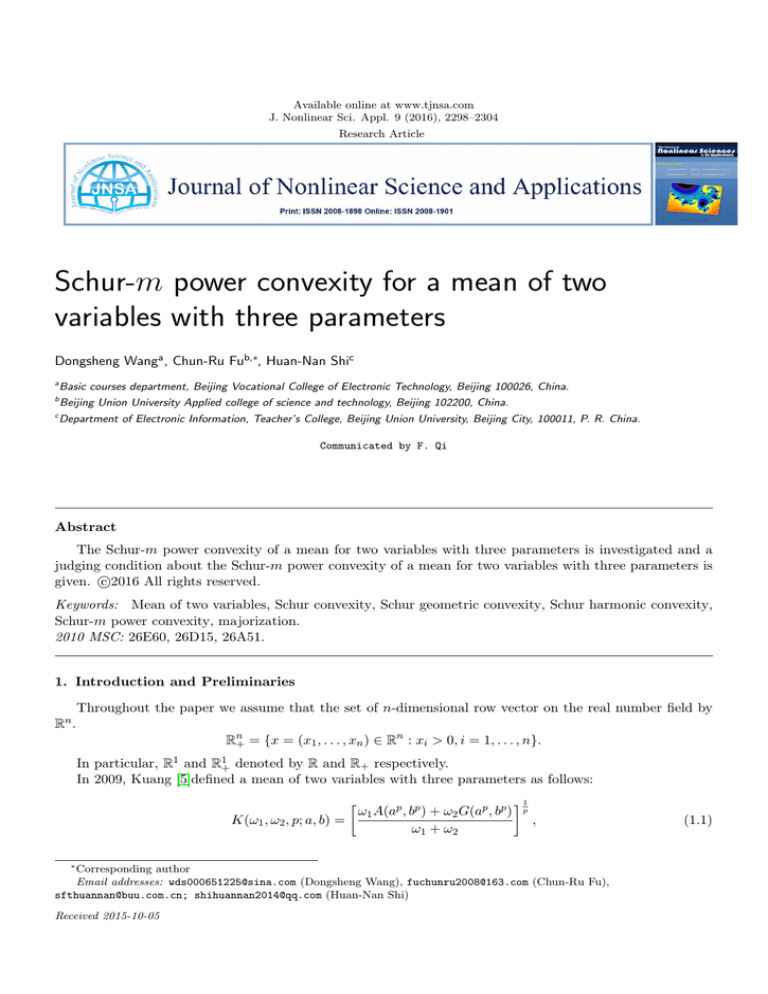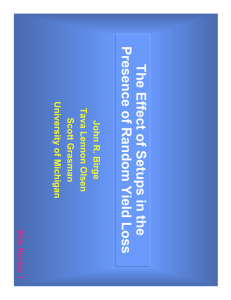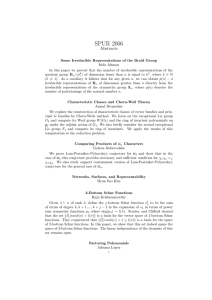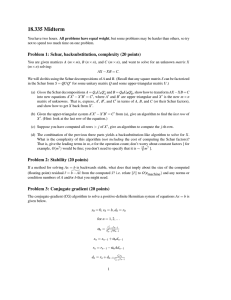
Available online at www.tjnsa.com
J. Nonlinear Sci. Appl. 9 (2016), 2298–2304
Research Article
Schur-m power convexity for a mean of two
variables with three parameters
Dongsheng Wanga , Chun-Ru Fub,∗, Huan-Nan Shic
a
Basic courses department, Beijing Vocational College of Electronic Technology, Beijing 100026, China.
b
Beijing Union University Applied college of science and technology, Beijing 102200, China.
c
Department of Electronic Information, Teacher’s College, Beijing Union University, Beijing City, 100011, P. R. China.
Communicated by F. Qi
Abstract
The Schur-m power convexity of a mean for two variables with three parameters is investigated and a
judging condition about the Schur-m power convexity of a mean for two variables with three parameters is
c
given. 2016
All rights reserved.
Keywords: Mean of two variables, Schur convexity, Schur geometric convexity, Schur harmonic convexity,
Schur-m power convexity, majorization.
2010 MSC: 26E60, 26D15, 26A51.
1. Introduction and Preliminaries
Throughout the paper we assume that the set of n-dimensional row vector on the real number field by
Rn .
Rn+ = {x = (x1 , . . . , xn ) ∈ Rn : xi > 0, i = 1, . . . , n}.
In particular, R1 and R1+ denoted by R and R+ respectively.
In 2009, Kuang [5]defined a mean of two variables with three parameters as follows:
ω1 A(ap , bp ) + ω2 G(ap , bp )
K(ω1 , ω2 , p; a, b) =
ω1 + ω2
∗
1
p
,
Corresponding author
Email addresses: wds000651225@sina.com (Dongsheng Wang), fuchunru2008@163.com (Chun-Ru Fu),
sfthuannan@buu.com.cn; shihuannan2014@qq.com (Huan-Nan Shi)
Received 2015-10-05
(1.1)
D. Wang, C.-R. Fu, H.-N. Shi, J. Nonlinear Sci. Appl. 9 (2016), 2298–2304
2299
√
where A(a, b) = a+b
ab respectively is the arithmetic mean and geometric mean of two
2 and G(a, b) =
positive numbers a and b, parameters p 6= 0, ω1 , ω2 ≥ 0 with ω1 + ω2 6= 0.
In particular,
ω
a + ω √ab + b
K 1, , 1; a, b =
2
ω+2
is the generalized Heron mean, which was introduced by Janous [4] in 2001.
ω
ap + ω(ab)p/2 + bp
K 1, , p, a, b =
2
ω+2
is the generalized Heron mean with parameter.
For simplicity, sometimes we will show K(ω1 , ω2 , p; a, b) by K(ω1 , ω2 , p) or K(a, b).
In recent years, the study on the properties of the mean with two variables by using theory of majorization
is unusually active.
Yang [18],[19],[20] generalized the notion of Schur convexity to Schur f -convexity, which contains the
Schur geometrical convexity, Schur harmonic convexity and so on. Moreover, he discussed Schur m-power
convexity of Stolarsky means [18], Gini means [19] and Daróczy means [20]. Subsequently, many scholars
have aroused the interest of Schur m-power convexity (see [2], [16], [17], [21]).
In this paper, the Schur-m power convexity of the mean K(ω1 , ω2 , p) is discussed, a judging condition
about the Schur-m power convexity of the mean K(ω1 , ω2 , p) is given.
Our main result is as follows:
Theorem 1.1.
(I) For m > 0,
ω2
ω1 )m, 2m}, then K(ω1 , ω2 , p) is Schur-m power convex with (a, b)
m ≤ p ≤ min{(1 + ωω12 )m, 2m}, then K(ω1 , ω2 , p) is Schur-m power concave with
0 ≤ p < m, then K(ω1 , ω2 , p) is Schur-m power concave with (a, b) ∈ R2+ ,
p < 0, then K(ω1 , ω2 , p) is Schur-m power concave with (a, b) ∈ R2+ .
(i) if p ≥ max{(1 +
(ii) if
(iii) if
(iv) if
∈ R2+ ,
(a, b) ∈ R2+ ,
(II) For m < 0,
(i) if p ≥ 0, then K(ω1 , ω2 , p) is Schur-m power convex with (a, b) ∈ R2+ ,
(ii) if m ≤ p < 0, then K(ω1 , ω2 , p) is Schur-m power convex with (a, b) ∈ R2+ ,
(iii) if 2m ≤ p < m and p = (1 +
with (a, b) ∈ R2+ ,
(iv) if p < 2m and p = (1 +
(a, b) ∈ R2+ .
ω2
ω1 )m,
ω1
ω2 )m,
(0 <
ω2
ω1
< 1), then K(ω1 , ω2 , p) is Schur-m power convex
( ωω21 > 1), then K(ω1 , ω2 , p) is Schur-m power concave with
2. Definitions and Lemmas
We need the following definitions and lemmas.
Definition 2.1 ([8, 15]). Let x = (x1 , . . . , xn ) and y = (y1 , . . . , yn ) ∈ Rn .
P
P
(i) x
said toP
be majorized by y (in symbols x ≺ y) if ki=1 x[i] ≤ ki=1 y[i] for k = 1, 2, . . . , n − 1 and
Pis
n
n
i=1 xi =
i=1 yi , where x[1] ≥ · · · ≥ x[n] and y[1] ≥ · · · ≥ y[n] are rearrangements of x and y in a
descending order,
(ii) Ω ⊂ Rn is called a convex set if (αx1 + βy1 , . . . , αxn + βyn ) ∈ Ω for any x and y ∈ Ω, where α and
β ∈ [0, 1] with α + β = 1,
D. Wang, C.-R. Fu, H.-N. Shi, J. Nonlinear Sci. Appl. 9 (2016), 2298–2304
2300
(iii) let Ω ⊂ Rn , ϕ: Ω → R is said to be a Schur-convex function on Ω if x ≺ y on Ω implies ϕ (x) ≤
ϕ (y) . ϕ is said to be a Schur-concave function on Ω if and only if −ϕ is Schur-convex function.
Definition 2.2 ([11, 22]). Let x = (x1 , . . . , xn ) and y = (y1 , . . . , yn ) ∈ Rn+ .
(i) Ω ⊂ Rn+ is called a geometrically convex set if (xα1 y1β , . . . , xαn ynβ ) ∈ Ω for any x and y ∈ Ω, where α and
β ∈ [0, 1] with α + β = 1,
(ii) let Ω ⊂ Rn+ , ϕ: Ω → R+ is said to be a Schur-geometrically convex function on Ω if (log x1 , . . . , log xn ) ≺
(log y1 , . . . , log yn ) on Ω implies ϕ (x) ≤ ϕ (y) . ϕ is said to be a Schur-geometrically concave function
on Ω if and only if −ϕ is Schur-geometrically convex function.
Definition 2.3 ([1, 9]). Let Ω ⊂ Rn+ .
(i) A set Ω is said to be a harmonically convex set if
and λ ∈ [0, 1].
x1 y1
λx1 +(1−λ)y1 , · · ·
xn yn
, λxn +(1−λ)y
n
∈ Ω for every x, y ∈ Ω
(ii) A function ϕ : Ω → R+ is said to be a Schur harmonically convex function on Ω if x11 , · · · , x1n ≺
1
1
,
·
·
·
,
implies ϕ(x) ≤ ϕ(y). A function ϕ is said to be a Schur harmonically concave function
y1
yn
on Ω if and only if −ϕ is a Schur harmonically convex function.
Definition 2.4 ([18]). Let f : R+ → R be defined by
m
x − 1 , m 6= 0;
f (x) =
m
log x,
m = 0.
(2.1)
Then a function φ : Ω ⊂ Rn+ → R is said to be Schur m-power convex on Ω if
(f (x1 ), f (x2 ), . . . , f (xn )) ≺ (f (y1 ), f (y2 ), . . . , f (yn ))
for all (x1 , x2 , . . . , xn ) ∈ Ω and (y1 , y2 , . . . , yn ) ∈ Ω implies φ(x) ≤ φ(y).
If −φ is Schur m-power convex, then we say that φ is Schur m-power concave.
If putting f (x) = x, log x, x1 in Definition 2.4, then definitions of the Schur-convex, Schur-geometrically
convex and Schur-harmonically convex functions can be deduced respectively.
Lemma 2.5 ([8, 15]). Let Ω ⊂ Rn is convex set and has a nonempty interior set Ω0 . Let ϕ : Ω → R is
continuous on Ω and differentiable in Ω0 . Then ϕ is the Schur − convex(Schur − concave)f unction if and
only if it is symmetric on Ω and if
∂ϕ
∂ϕ
(x1 − x2 )
−
≥ 0(≤ 0)
∂x1 ∂x2
holds for any x = (x1 , · · · , xn ) ∈ Ω0 .
Lemma 2.6 ([11, 22]). Let Ω ⊂ Rn+ be a symmetric geometrically convex set with a nonempty interior Ω0 .
Let ϕ : Ω → R+ be continuous on Ω and differentiable on Ω0 . Then ϕ is a Schur geometrically convex
(Schur geometrically concave) function if and only if ϕ is symmetric on Ω and
∂ϕ
∂ϕ
(x1 − x2 ) x1
− x2
≥ 0 (≤ 0)
(2.2)
∂x1
∂x2
holds for any x = (x1 , · · · , xn ) ∈ Ω0 .
D. Wang, C.-R. Fu, H.-N. Shi, J. Nonlinear Sci. Appl. 9 (2016), 2298–2304
2301
Lemma 2.7 ([1, 9]). Let Ω ⊂ Rn+ be a symmetric harmonically convex set with a nonempty interior Ω0 . Let
ϕ : Ω → R+ be continuous on Ω and differentiable on Ω0 . Then ϕ is a Schur harmonically convex (Schur
harmonically concave) function if and only if ϕ is symmetric on Ω and
2 ∂ϕ
2 ∂ϕ
(x1 − x2 ) x1
− x2
≥ 0 (≤ 0)
(2.3)
∂x1
∂x2
holds for any x = (x1 , · · · , xn ) ∈ Ω0 .
Lemma 2.8 ([18]). Let Ω ⊂ Rn+ be a symmetric set with nonempty interior Ω◦ and ϕ : Ω → R+ be continuous
on Ω and differentiable in Ω◦ . Then ϕ is Schur m-power convex on Ω if and only if ϕ is symmetric on Ω
and
m
xm
1−m ∂ϕ(x)
1−m ∂ϕ(x)
1 − x2
x1
− x2
≥ 0, if m 6= 0
(2.4)
m
∂x1
∂x2
and
∂ϕ(x)
∂ϕ(x)
(log x1 − log x2 ) x1
− x2
≥ 0,
∂x1
∂x2
if m = 0
(2.5)
for all x ∈ Ω◦ .
Lemma 2.9. Let
p
p
p
g(x) = ω1 (p − m)x 2 − ω2 xm + ω2 ( − m), x ∈ [1, ∞),
2
2
where ω1 ≥ 0, ω2 ≥ 0, m ∈ R and m 6= 0.
(2.6)
(I) For m > 0,
(i)
(ii)
(iii)
(iv)
if
if
if
if
p ≥ max{(1 + ωω21 )m, 2m}, then g(x) ≥ 0,
m ≤ p ≤ min{(1 + ωω12 )m, 2m}, then g(x) ≤ 0,
0 ≤ p < m, then g(x) ≤ 0,
p < 0, then the symbol of g(x) is not fixed (from negative to positive).
(II) For m < 0,
(i)
(ii)
(iii)
(iv)
if
if
if
if
p ≥ 0, then g(x) > 0,
m ≤ p < 0, then g(x) ≥ 0,
2m ≤ p < m and p = (1 + ωω21 )m, (0 < ωω21 < 1), then g(x) ≥ 0,
p < 2m and p = (1 + ωω21 )m, ( ωω21 > 1), then g(x) ≤ 0.
Proof. From (2.6), we have
and
p
p
ω2
g(1) = ω1 (p − m) − ω2 + ω2 ( − m) = ω1 [p − (1 + )m]
2
2
ω1
(2.7)
p p
p
p
0
g (x) = ω1 (p − m) x 2 −1 − ω2 m xm−1 = xm−1 h(x),
2
2
2
(2.8)
where
p
h(x) = ω1 (p − m)x 2 −m − ω2 m.
(2.9)
(I) For m > 0,
(i) if p ≥ max{(1 +
ω2
ω1 )m, 2m},
then p > 0 and
h(x) ≥ ω1 (p − m) − ω2 m = g(1) ≥ 0,
0
so for x ∈ [1, ∞), we have g (x) ≥ 0 and then, g(x) ≥ g(1) ≥ 0,
(2.10)
D. Wang, C.-R. Fu, H.-N. Shi, J. Nonlinear Sci. Appl. 9 (2016), 2298–2304
2302
(ii) if m ≤ p ≤ min{(1 + ωω21 )m, 2m}, then it is easy to see that the inequality (2.10) is reversed, so
0
for x ∈ [1, ∞), we have g (x) ≤ 0 and then, g(x) ≤ g(1) ≤ 0,
0
(iii) if 0 ≤ p < m, then h(x) ≤ 0 and g(1) ≤ 0, so for x ∈ [1, ∞), we have g (x) ≤ 0 and then,
g(x) ≤ g(1) ≤ 0,
0
(iv) if p < 0, then h(x) ≤ 0, so for x ∈ [1, ∞), we have g (x) ≥ 0, this means that g(x) is increasing on
p
[1, ∞). For p < 0, notice that limx→+∞ x 2 = 0, from (2.6), it is easy to see that limx→+∞ g(x) =
+∞, but g(1) < 0, so the symbol of g(x) is not fixed (from negative to positive) on [1, ∞).
(II) For m < 0,
0
(i) if p ≥ 0, then h(x) ≥ 0, so for x ∈ [1, ∞), we have g (x) ≥ 0 and then, g(x) ≥ g(1) > 0,
0
(ii) if m ≤ p < 0, then h(x) ≥ 0, so for x ∈ [1, ∞), we have g (x) ≤ 0 and then, g(x) ≥
limx→+∞ g(x) = ω2 ( p2 − m) ≥ 0,
(iii) if 2m ≤ p < m and p = (1 +
ω2
ω1 )m,
(0 <
ω2
ω1
< 1), then
h(x) ≤ ω1 (p − m) − ω2 m = g(1) = 0,
(2.11)
0
so for x ∈ [1, ∞), we have g (x) ≥ 0 and then, g(x) ≥ g(1) = 0,
(iv) if p < 2m and p = (1 +
ω2
ω1 )m,
( ωω21 > 1), then
h(x) ≥ ω1 (p − m) − ω2 m = g(1) = 0,
0
so for x ∈ [1, ∞), we have g (x) ≤ 0 and then, g(x) ≤ g(1) = 0.
3. Proof of Theorem 1.1
Proof. From the definition of K(ω1 , ω2 , p), we have
p
p +ap
K(ω1 , ω2 , p) =
ω1 a
p
+ ω2 a 2 b 2
2
ω1 + ω2
!1
p
.
It is clear that K(ω1 , ω2 , p) is symmetric with (a, b) ∈ R2+ .
Write
"
# 1 −1
p p
ω1 (ap + ap ) + 2ω2 a 2 b 2 p
s(a, b) :=
.
2(ω1 + ω2 )
Then
and then
f (a, b) :=
p
ω1 ap−1 + ω2 a 2 −1 b 2
ω1 + ω2
∂K
= s(a, b)
∂b
ω1 bp−1 + ω2 a 2 b 2 −1
ω1 + ω2
am − bm
∆ :=
m
where
p
∂K
= s(a, b)
∂a
p
p
!
,
!
,
s(a, b)
1−m ∂K
1−m ∂K
a
−b
=
f (a, b),
∂a
∂b
2(ω1 + ω2 )
p
p
p p
am − bm
[ω1 (ap−m − bp−m ) + ω2 (a 2 −m b 2 − a 2 b 2 −m )].
m
(2.12)
D. Wang, C.-R. Fu, H.-N. Shi, J. Nonlinear Sci. Appl. 9 (2016), 2298–2304
Without loss of generality, we may assume that a ≥ b, then z :=
∆=
where
a
b
2303
≥ 1 and then
s(a, b)bp
zm − 1
q(z),
·
2(ω1 + ω2 )
m
p
p
(3.1)
p
p
q(z) = ω1 (z p−m − 1) + ω2 (z 2 −m − z 2 ) = ω1 z p−m + ω2 z 2 −m − ω2 z 2 − ω1 ,
p
p
p p
p
0
q (z) = ω1 (p − m)z p−m−1 + ω2 ( − m)z 2 −m−1 − ω2 z 2 −1 = z 2 −m−1 g(z).
2
2
(I) For m > 0,
0
(i) if p ≥ max{(1+ ωω12 )m, 2m}, by (I)(i) from Lemma 2.9, it follows that q (z) ≥ 0, so q(z) ≥ q(1) = 0.
Notice that
s(a, b)bp
zm − 1
> 0,
≥ 0,
2(ω1 + ω2 )
m
from (3.1), we have ∆ ≥ 0 and by Lemma 2.8, it follows that K(ω1 , ω2 , p) is Schur-m power
convex with (a, b) ∈ R2+ .
By the same arguments, from (I)(ii) and (I)(iii) in Lemma 2.9 we can prove (I)(ii) and (I)(iii)
in Theorem 1.1, respectively,
0
(iv) if p < 0, then from (I)(iv) in Lemma 2.9, it follows that the symbol of q (z) is not fixed (from
negative to positive). This means that q(x) first decreases and then increases, but q(1) = 0 and
p
p
lim q(z) = lim (ω1 z p−m + ω2 z 2 −m − ω2 z 2 − ω1 ) = −ω1 < 0,
z→+∞
z→+∞
hence q(z) ≤ 0 and then ∆ ≤ 0, by Lemma 2.8, it follows that K(ω1 , ω2 , p) is Schur-m power
concave with (a, b) ∈ R2+ .
By analogous discussing with case (I), from (II)(i), (II)(ii), (II)(iii) and (II)(iv) in Lemma 2.9, we can
prove (II)(i), (II)(ii), (II)(iii) and (II)(iv) in Theorem 1.1, respectively. The detailed proofs are left to
the reader.
The proof of Theorem 1.1 is complete.
In recent years, the study on the properties of the mean with two variables by using theory of majorization
is unusually active, interested readers can also refer to the references [3, 4, 5, 6, 7, 8, 9, 10, 11, 12, 13, 14].
Acknowledgements
The authors are indebted to the referees for their helpful suggestions.
References
[1] Y. M. Chu, G. D. Wang, X. H. Zhang, The Schur multiplicative and harmonic convexities of the complete
symmetric function, Math. Nachr., 284 (2011), 653–663. 2.3, 2.7
[2] Y. P. Deng, S. H. Wu, D. He, The Schur Power convexity for the generalized Muirhead mean, Math. pract. theory,
5 (2014), 255–268. 1
[3] W. M. Gong, H. Sun, Y. M. Chu, The Schur convexity for the generalized muirhead mean, J. Math. Inequal., 8
(2014), 855–862. 3
[4] W. Janous, A note on generalized Heronian means, Math. Inequal. Appl., 4 (2001), 369–375. 1, 3
[5] J. C. Kuang, Applied Inequalities (Changyong budengshi), Hunan Jiaoyu Chubanshe, Changsha, (1989). 1, 3
[6] V. Lokesha, N. Kumar, K. M. Nagaraja, S. Padmanabhan, Schur geometric convexity for ratio of difference of
means, J. Sci. Res. Reports, 3 (2014), 1211–1219. 3
D. Wang, C.-R. Fu, H.-N. Shi, J. Nonlinear Sci. Appl. 9 (2016), 2298–2304
2304
[7] V. Lokesha, K. M. Nagaraja, N. Kumar, Y. D. Wu, Schur convexity of Gnan mean for two variables, NNTDM,
17 (2011), 37–41. 3
[8] A. W. Marshall, I. Olkin, Inequalities:theory of majorization and its application, Springer, New York, (1979). 2.1,
2.5, 3
[9] J. Meng, Y. M. Chu, X. M. Tang, The Schur-harmonic-convexity of dual form of the Hamy symmetric function,
Mat. Vesnik, 62 (2010), 37–46. 2.3, 2.7, 3
[10] K. M. Nagaraja, S. K. Sahu, Schur harmonic convexity of Stolarsky extended mean values, Scientia Magna, 9
(2013), 18–29. 3
[11] C. P. Niculescu, Convexity according to the geometric mean, Math. Inequal. Appl., 3 (2000), 155–167. 2.2, 2.6, 3
[12] J. Sándor, The Schur-convexity of Stolarsky and Gini means, Banach J. Math. Anal., 1 (2007), 212–215. 3
[13] F. Qi, J. Sándor, S. S. Dragomir, A. Sofo, Notes on the Schur- convexity of the extended mean values, Taiwanese
J. Math., 9 (2005), 411–420. 3
[14] H. N. Shi, Y. M. Jiang, W. D. Jiang, Schur-convexity and Schur-geometrically concavity of Gini mean, Comput.
Math. Appl., 57 (2009), 266–274. 3
[15] B. Y. Wang, Foundations of majorization inequalities, Beijing Normal University Press, Beijing, (1990). 2.1, 2.5
[16] W. Wang, S. Yang, Schur m-power convexity of a class of multiplicatively convex functions and applications,
Abstr. Appl. Anal, 2014 (2014), 12 pages. 1
[17] Q. Xu, Reserch on Schur p power-convexity of the quotient of arithmetic mean and geometric mean, J. Fudan
Univ. (Natural Science), 54 (2015), 288–295. 1
[18] Z. H. Yang, Schur power convexity of Stolarsky means, Publ. Math. Debrecen, 80 (2012), 43–66. 1, 2.4, 2.8
[19] Z. H. Yang, Schur power convexity of Gini means, Bull. Korean Math. Soc., 50 (2013), 485–498. 1
[20] Z. H. Yang, Schur power comvexity of the daróczy means, Math. Inequal. Appl., 16 (2013), 751–762. 1
[21] H. P. Yin, H. N. Shi, F. Qi, On Schur m-power convexity for ratios of some means, J. Math. Inequal., 9 (2015),
145–153. 1
[22] X. M. Zhang, Geometrically convex functions, Hefei: Anhui University Press, Anhui, (2004). 2.2, 2.6






